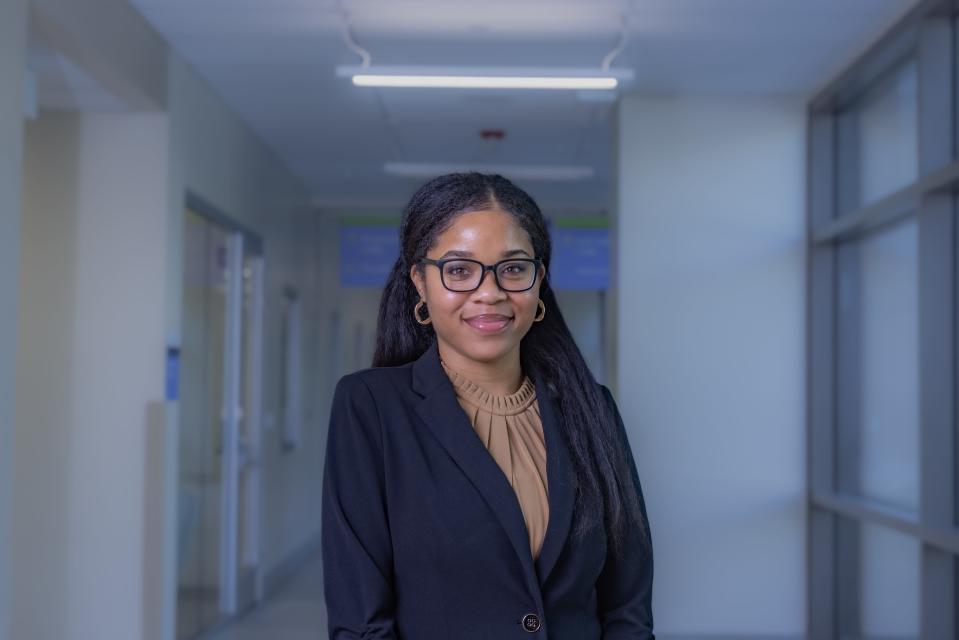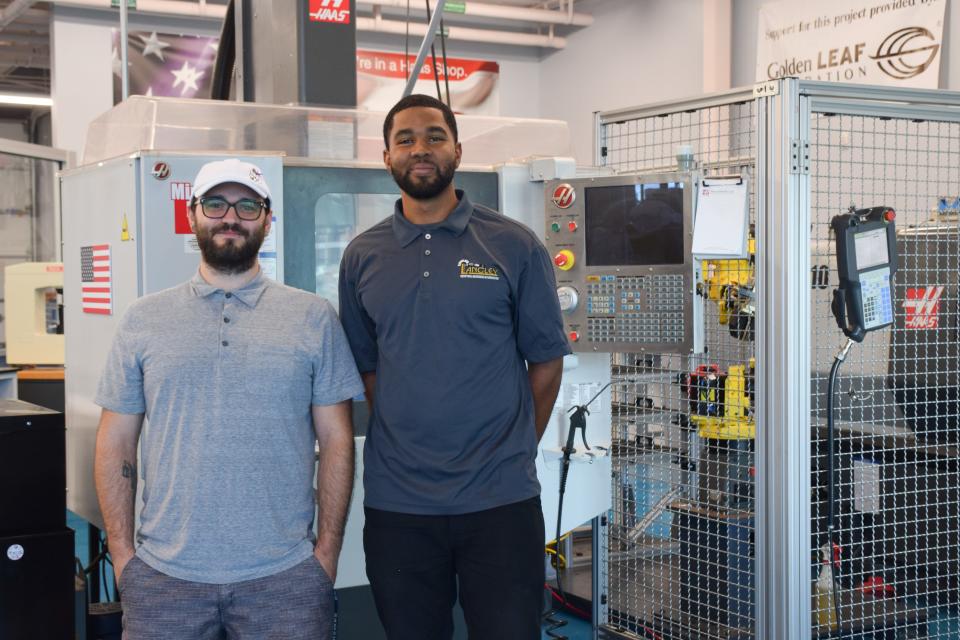Student loan debt: How 5 people went to school and avoided it (Spoiler alert: It's hard)
- Oops!Something went wrong.Please try again later.
- Oops!Something went wrong.Please try again later.
Last year saw failed attempts to forgive student loans en masse and a herky-jerky return to loan payments after a long hiatus. It was also a year that raised fresh questions about whether a college degree really pays off in the long run.
Despite that, Americans are generally undeterred in their pursuit of higher education. The number of prospective college students creating Common App accounts to apply to schools in 2023 surged, including among those who would be the first in their families to go to college and students of color. A disproportionate share of the nation’s nearly $2 trillion in student loan debt is carried by women. Black women in particular owe an outsize sum.
Does it have to be this way? Is it possible to go to college without taking out student loans or find a well-paid job without a degree? USA TODAY spoke with college students, graduates and dropouts about getting the skills or degrees required to become professionals, without going into significant debt. Unless a student’s family can underwrite their education or secure a coveted scholarship that covers the growing price of a degree, it’s very difficult.
A TikTok video turned a college dropout into an apprentice
Janika Cook did what a lot of other students at her high school did after graduation: She went to college. She and her twin sister set off for school in 2014, where she launched into a degree in political science. Even with limited financial support from her family and grants that covered some of her tuition, she quickly accumulated tens of thousands of dollars in student loan debt just one year into school.
Cook, 27, enrolled in a local community college, working at the same time to cover the costs. She found the combination overwhelming and quit those classes, too. Eventually she found an internship at a nonprofit, working in fundraising. Cook loved building databases and reports for the nonprofit’s leaders about its financials, donations, who was donating and why.
The pandemic, however, meant the end of that role. Cook went on to find work at a home improvement store, then as a waitress, “so I’m not totally just unemployed. But I was definitely underemployed. I wasn’t able to pay all of my bills.”
Then she saw a TikTok video.
It was from a company called Multiverse, a United Kingdom-based startup cofounded by Euan Blair, the eldest son of former British Prime Minister Tony Blair.

Multiverse partners with employers that pay to recruit and train future employees or reskill existing workers. Like Cook, many Multiverse apprentices lack degrees, but as apprentices they become full-time, salaried employees. Workers at companies including Taco Bell have shifted from running cash registers to designing software for its parent corporation through Multiverse apprenticeships.
“We’re basically trying to change this link between education and employment,” Blair said. “The assumption’s been you have to go to college.” While people who earn bachelor’s degrees can make more than people who have only a high school diploma, they may also pay a steep price for that credential, undermining their edge in wages, and many people accrue student loan debt but never complete their degrees.
In the United States, about two-thirds of apprenticeships are granted to people who are white. At Multiverse, according to Blair, more than half of the thousands of apprentices it has worked with in the United Kingdom and United States are people of color.
Blair lamented the disparity in government investment in colleges and universities compared with apprenticeships. During the 2020-21 academic year, spending on public higher education was about $450 billion, according to federal data, compared with $14 billion on apprenticeship programs. Congress pointed more federal money at apprenticeships in late 2022, and the Biden administration has touted the option as “a high-quality, debt-free” path to work.
Cook started apprenticing in June 2022, earning $55,000 as she learned coding languages and data analytics skills while working remotely for a Utah-based health care company. She’s done apprenticing and now makes $67,000 a year – enough to make her student loan payments.
Student loan relief talks: No final answer on who should get help
Her fast-food job came with an unexpected perk
Kathi Schronce already had one degree and one set of student loans paid off by the time she found herself looking for a job at an Indiana McDonald’s. She needed a flexible position that would help support her six children, including a 1-year-old daughter and several foster kids she’d adopted.

Her family had moved rather suddenly across the state for her husband’s job, leaving them with payments for the home they left behind as well as rent on the double-wide trailer they had just moved into. If Schronce could work nights and weekends, she could care for her youngest child by day and her husband could take over the rest of the time.
Schronce, now 47, was a teacher for 11 years, with her salary for teaching high school German and American history, among other subjects, barely topping $40,000 a year – roughly what she owed in student loan debt for her teaching degree from Indiana University.
But after taking parental leave for her youngest child, at 40, she wasn’t offered a full-time teaching role. Then came the cross-state move and the cash crunch.
When she showed up at McDonald’s in dress shoes, slacks and a jacket, the manager was puzzled. “We just moved to town,” she remembers explaining. “We’re broke and I need a job.”
She was hired.
Not only that: Schronce discovered that McDonald's, even for part-time employees clocking just 15 hours a week, would cover a portion of tuition for workers pursuing almost any degree after three months on the job. The burger chain pays the entire cost of degrees for employees who attend specific colleges. She also learned that IU would grant her a second bachelor’s degree, in nursing, in four semesters because she already had another undergraduate credential.
The McDonald’s tuition assistance benefit, $2,500 a year for employees and a little more for managers, is a perk that’s become especially common at midsize and large companies to help retain employees. Target reported that more than 25,000 of its employees had used its program as of April 2023, and as of 2021, Chipotle partners with more than 20 institutions and covers the cost of more than 300 different programs.
Research into the programs raises questions about their value, with some employers limiting the schools employees can attend or requiring them to pay tuition and fees up front and get paid back later. But the financial help was critical to Schronce completing her program and minimizing how much she borrowed: about $10,000 for her second degree, which she received in the spring of 2021.
“It was worth getting a McDouble thrown at me a few times,” she quipped, referring to a sandwich that has two patties bookending a slice of cheese.
The payoff on other sacrifices is yet to be seen. Her husband attended IU, a public university, for law school, graduating in 2013 with about $100,000 in debt. His balance at one point ballooned beyond what he originally borrowed because of interest.
The couple made payments during the COVID-triggered pause on student loan bills, since all of what they paid would drive down the principal. And because her husband is a public servant and on an income-driven repayment plan, Schronce said her husband is counting on the balance of his loans to be erased after about a decade of work.
Although she’s kept her teaching license active, now Schronce works as a post-anesthetia care unit, or PACU, nurse – caring for patients coming out of surgery.
“I would still teach German if it paid as well as being a nurse,” she said.
Her advice to those considering higher education is to knock out as many classes as possible at relatively low-cost community colleges – and to consider employers with tuition assistance programs.
“Eighteen-year-olds can’t get loans for something tangible,” but they can take out thousands in student loans, Schronce said. “I don’t know if the students understand how much money that is.”
Community college drew students for whom loans weren’t an option
For Deven Scoggins and Troy Chappell, attending any college that would lead to a big student loan balance was out of the question.
Scoggins, 26, briefly enrolled in community college after graduating high school in 2015. Three days later, he withdrew, unsure what to pursue and unwilling to spend thousands while he figured it out. He worked various jobs, briefly aspiring to be a plumber or pipefitter. COVID-19, Scoggins found, meant he no longer had opportunities to become an apprentice and get essential on-the-job training.
Meanwhile, 27-year-old Chappell was working at a Walmart in eastern North Carolina when his first son was born almost two years ago. Fatherhood became an incentive for him to find a more financially secure path than the one he was on. Like Scoggins, he wasn’t entirely sure what to pursue, however, and neither wanted to go into debt while trying to figure it out.
Student loans are often linked to four-year colleges, but a growing share of people attending two-year colleges, typically considered to be a low-cost source of education, are taking on student loan debt, too.
Both found their way to a program at Nash Community College in Rocky Mount, North Carolina, where courses cost only about $100, including fees, per credit hour. In comparison, the per-credit-hour cost at the University of North Carolina is almost three times that, excluding fees.
“The cost of college definitely affected my decision,” Chappell said. He and Scoggins have siblings with student loan debt.
Chappell and Scoggins are working on associate degrees under the umbrella of advanced manufacturing, covering their expenses with a combination of scholarships and grants. (For some community college students, however, paying for rent and groceries on top of classes is a struggle.)

The two-year program is designed to fill jobs like those that help manufacturers – companies that produce everything from tires to medicines – make the machinery and infrastructure used on the assembly lines and in plants. “You’re helping a company that does have an assembly line make the assembly line itself,” Scoggins said.
When they graduate, they expect no trouble finding a high-paying job in the area. According to the National Association of Manufacturers, the United States could have more than 2 million unfilled manufacturing jobs by 2030.
“The salaries would be much greater than the tuition costs here,” Scoggins said. And if someone did take out loans to attend, he said he thinks they would easily recoup the cost.
Student loan debt buries parents, too. There are few solutions.
This student avoids borrowing at a ‘no-loan’ college
As a high school freshman, Beck Lambert declared to their guidance counselor that they would attend college and do so without going into debt.
No one in their family had been to college. And there was no money to pay for their degree.
In fifth grade, their father, a computer programmer, had a heart attack that deprived the supply of oxygen to his brain, leaving him alive but unable to work. Lambert’s mother, up to that point a stay-at-home parent, took a job cleaning classrooms at the Catholic school Beck and their sisters attended in New Hampshire to offset the cost of tuition.
Ever since, Lambert, who uses the pronouns they and them, has taken a similar approach to financing their education. They received a partial scholarship to Lincoln Academy, a private college preparatory school in Newcastle, Maine. The caveat was that Lambert had to volunteer 100 hours a year to attend, working in the dining hall, gathering answer sheets during math competitions, chasing soccer balls during matches.

It would prepare Lambert for Grinnell College’s then-new “no-loan” approach to covering tuition and other expenses, which excludes loans when presenting students with a plan for financing their education. It would mean they could live up to their ninth-grade ambition to go to college without going into debt. But it would take serious work.
Grinnell, a private liberal arts college in Iowa, works with families to calculate the whole cost of attending, said Brad Lindberg, the college’s associate vice president of institutional initiatives and enrollment. That includes not just tuition and fees, but also room and board, books, travel to and from college and other expenses.
Families provide financial information that shows how much they can contribute. For instance, if the overall cost is $50,000 and the family can pay $20,000, Lindberg said, Grinnell would work out covering the other $30,000. (Grinnell’s website projects the cost of attendance for the 2024-25 academic year will be about $87,000.)
Many other colleges would try to fill the gap by suggesting student loans.
“We leave no gap,” Lindberg said. “We would not include a loan, which is where the term ‘no loan’ comes from.” The college made the shift during the 2021-22 academic year because of the pandemic. While loans aren’t included in students’ financial aid packages, families can choose to take them out anyway.
Lambert has chosen to take a heavy load of classes, enough to yield a degree in three years instead of four to save money. And to avoid loans, the college helped set them up with two jobs. One is helping classmates access professional clothing, sifting through donations to do so. The other is assisting on a project dedicated to digitizing Haitian art.
Though Lambert’s schedule is at times grueling, they have rarely had to borrow money to pay for school. Lambert has asked their parents for small amounts from time to time and knows fellow students who have borrowed as well. But “it’s negligible compared with people taking out $80,000," they said. "It’s $2,000 or $3,000.”
Lambert, who is majoring in history with a concentration in American studies, is in the midst of considering graduate school. Many graduate programs leave their participants with more debt than they initially borrowed, in jobs with incomes insufficient to pay off the balance.
Their plans come with strict criteria: Lambert is applying only to programs that fully cover master’s degree tuition.
This article originally appeared on USA TODAY: Student loan debt is difficult to avoid. Here's how some did it

